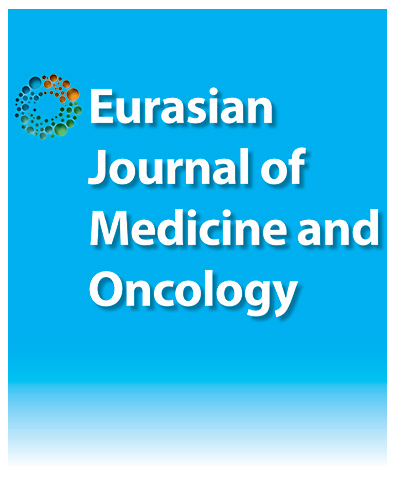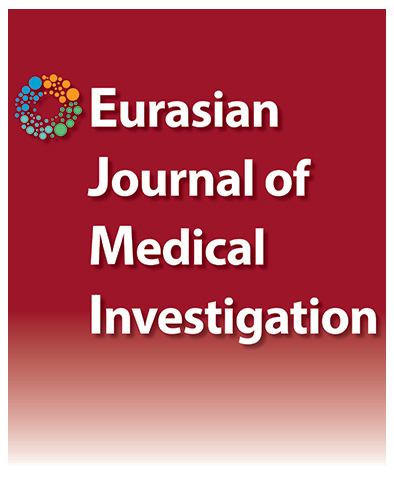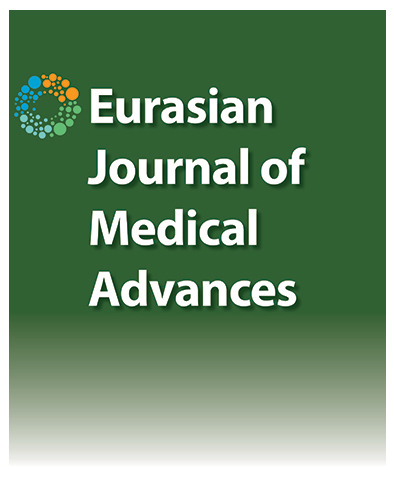Volume: 3 Issue: 3 - 2023
| REVIEW | |
| 1. | Ramsey Hunt Syndrome: A Review Article Halil İbrahim Altıner doi: 10.14744/ejma.2023.65265 Pages 85 - 87 Ramsey Hunt Syndrome (RHS) is a disease caused by the varicella-zoster virus (VZV). After first encountering VZV infection, the virus persists in the sensory ganglia of the spinal and cranial nerves for life. Herpes zoster oticus is a condition characterized by severe otalgia and erythematous vesicular rash in the external ear canal and auricle, caused by viruses that reactivate in the facial nerve and geniculate ganglion, especially in people with weakened immune systems due to various diseases or drugs. The picture formed by the addition of peripheral facial paralysis to the table is called RHS. Other cranial nerves may also be involved through various anatomical connections. Antiviral agents and corticosteroids are useful in treatment. Early diagnosis and treatment are important. |
| 2. | Navigating Neurologic Adverse Events in Immune Checkpoint Inhibitor Therapy: Challenges and Strategies Arzu Aldemir Atmaca doi: 10.14744/ejma.2023.94830 Pages 88 - 104 The advancement of immunotherapy has changed cancer treatment. Immune checkpoint inhibitors (ICIs) are one of the groundbreaking immunotherapies that have offered patients with advanced cancer new optimism by utilizing the immune system's innate ability to fight cancer with amazing success. Nevertheless, this exceptional approach has drawbacks, including the range of immune-related adverse events (irAEs) that can arise due to ICI therapy. IrAEs that impact various parts and systems of the body can be particularly problematic, and can be difficult to identify and manage. Neurological side effects of ICIs are of particular interest, as they may vary from minor sensory issues to possibly fatal neuroinflammatory reactions. The purpose of this review is to elucidate the peculiarities of neurological immune-related adverse events (n-irAEs) associated with ICIs and to provide a complete overview of the various facets of ICI therapy by exploring the mechanisms, clinical manifestations, and management strategies of n-irAEs. Furthermore, it is crucial to emphasize the importance of caution, early recognition, and collaboration between oncologists and neurologists to optimize patient outcomes while overcoming the challenges posed by these enigmatic neurologic complications. |
| 3. | Pesticides and Their Effects on Worker Health Yasemin Yurt, Seher Kurtul doi: 10.14744/ejma.2024.28190 Pages 105 - 113 There are more than 1000 types of pesticides used worldwide, especially in agriculture, as well as in homes, offices, landscaping and gardens. The use of pesticides is inevitable in obtaining sufficient and healthy products from agriculture for nutrition in life sustaining. In people exposed to pesticides; Acute and chronic harmful effects are observed depending on the type of pesticide used, the dose used and the duration of use. It has been shown that chronic exposure can cause diseases such as diabetes, thyroid dysfunction, asthma, and cancer. Necessary precautions should be taken when using pesticides to eliminate or reduce their harm to human health. Reducing pesticide use is the responsibility of both the producer, the consumer and the state. To protect workers from pesticides, appropriate measures should be taken according to risk assessment at each stage. In order to eliminate the risk in the workplace environment, it should be replaced with another substance if possible, and if not, exposure should be reduced by using the necessary prevention and protection methods. Since pesticide use is widespread in our country, we wanted to examine its effects on human health in the light of the literature. |
| 4. | Difficulties in the Diagnosis and Management of Fetal Growth Restriction Barbaros Ateşli doi: 10.14744/ejma.2023.88528 Pages 114 - 119 Fetal growth restriction (FGR) is an important topic in perinatal medicine that results from impaired placental function and has poor perinatal outcomes. However, there is a lack of consensus on diagnostic criteria and management strategies worldwide. While some clinicians consider only fetal size in the diagnosis, others disagree and recommend adding fetal growth velocity Doppler indices to the diagnostic criteria. Different strategies are followed for pregnancy follow-up and delivery decision-making. There are different opinions on which Doppler measurements of vessels such as the umbilical artery, middle cerebral artery, and ductus venosus should be performed during follow-up. To assess fetal well-being and to decide on delivery, methods such as cardiotocography, computed cardiotocography, biophysical profile scoring, and biophysical profile scoring are used or not used. The Society of Maternal-Fetal Medicine (SFMF) and the International Society of Ultrasound in Obstetrics and Gynecology (ISUOG) published guidelines in the same year. However, their perspectives on fetal growth restriction were quite different. We basically analyzed the differences between these two guidelines and the reasons for the differences. As a result, we presented our own practice. |
| RESEARCH ARTICLE | |
| 5. | Histomorphological Changes in Campanacci Grade III Giant Cell Tumors After Use of Denosumab in a Neoadjuvant Setting Rahma Rashid, Shaheera Malik, Sheikh Muhammad Ebad Ali, Badaruddin Sahito, Sarush Siddiqui, Muhammed Mubarak doi: 10.14744/ejma.2023.52523 Pages 120 - 126 Objectives: To determine the histomorphological changes induced in Campanacci grade III giant cell tumors (GCTs) of bones by a short course of denosumab in a neoadjuvant setting. Methods: This is a retrospective study of all adult patients with biopsy-proven GCTs of bones, Campanacci grade III, treated by denosumab at a single tertiary care hospital in Pakistan from January 2014 till December 2020. Data items were extracted from the case records of patients and histopathological reports. Optimal histological response was defined as ≥50% decrease in giant cells with fibrosis and ossification. Data analysis was done by SPSS version 22.0. Results: The mean age of 28 patients was 31.8±12.4 years with 15 (53.6%) males and 13 (46.4%) females. Tibia, femur, radius, pelvic girdle, humerus and ulna were involved in 9 (32.1%), 8 (28.6%], 6 (21.4%), 2 (7.1%), 2 (7.1%) and 1 (3.5%) patients, respectively. The optimal histological response was obtained in 25 (89.3%) cases. Denosumab-induced changes were noted in all except one (3.6%) case. In 11 (39.3%) patients, complete necrosis was found. In rest, variable amount of viable tumor (range: 2 to 100%) and denosumab-induced changes were observed. Conclusion: Denosumab in neoadjuvant setting induces significant histomorphological changes in high-grade GCTs. |
| 6. | Maternal and Fetal Outcomes in Adolescent Pregnancies Barbaros Ateşli, Kenan Sofuoğlu doi: 10.14744/ejma.2023.83803 Pages 127 - 129 Objectives: Adolescent period and pregnancies during this period is a controversial issue with many aspects and should be addressed both socially and medically. Although this situation is more common in Turkey, it is an important health problem worldwide. Adolescent pregnancies are high-risk maternal and fetal pregnancies. Our study aimed to evaluate maternal and fetal outcomes in adolescent pregnancies. Methods: In this study, the records of 2088 adolescent pregnant women aged 18 years and younger who gave birth in the Gynecology and Obstetrics Clinic of Zeynep Kamil Women's and Children's Hospital between 1996 and 1997, and the records of adult pregnant women aged 19 years and older who were examined as a control group were retrospectively analyzed. Demographic characteristics, presentation, indications for hospitalization, mode of delivery, obstetric outcomes, and obstetric complications of adolescent and adult patients who gave birth in our hospital were compared. Results: It was found that 2088 adolescent pregnant women included in the study had a singleton delivery. Compared with the control group, it was found that the threat of preterm delivery was higher, birth weight was lower, and the cesarean section rate was higher. Conclusion: Adolescent pregnancies were found to be at risk for preterm delivery, IUGR, fetal distress, low APGAR score, and low birth weight, and antenatal follow-up was less frequent in adolescent pregnancies. Healthcare workers should be careful about the prevention and risks of adolescent pregnancies and frequent antenatal follow-up if detected. |
| 7. | Effects of Cyclosporin A, Mycophenolate Mofetile, Vitamin A, D, E and N-Acetyl Systein in Rats With Nephrotic Syndrome Yunus Emre Baysal, Ayfer Gür Güven, Sema Akman doi: 10.14744/ejma.2023.43434 Pages 130 - 139 Objectives: Patients with steroid-resistant nephrotic syndrome have a high risk of developing chronic renal failure. Cyclosporine A used in treatment is nephrotoxic. Data on the efficacy of mycophenolate mofetil used in the treatment are insufficient. New treatment options should be explored. Our research aims to investigate the effectiveness of cyclosporine A, mycophenolate mofetil, vitamin A, D, E, N-acetyl cysteine and their combinations in rats with nephrotic syndrome. Methods: The research was conducted with 48 adult male rats of the Wistar-albino. To induce nephrotic syndrome, two doses of adriamycin were administered to all rats 20 days apart. Serum creatinine, albumin, cholesterol, triglyceride, total oxidant status, total antioxidant status, protein in urine, creatinine, and creatinine clearance were analyzed in rats. Glomerulosclerosis index, total injury score, interstitial fibrosis score, TGF-and osteopontin analyzes were performed within the scope of the histopathological evaluation. Results: At the end of the study, the lowest 24-hour urine protein was found in group B (cyclosporin A + vit ACE), and the highest 24-hour urine protein in group C (mycophenolate mofetil). The highest serum creatinine, triglyceride, and cholesterol and the lowest serum albumin levels are in group A (cyclosporine A). The lowest serum creatine, triglyceride, and cholesterol and the highest serum albumin levels are in group D (mycophenolate mofetil + vit ADE). Conclusion: It has been observed that vitamin ACE added to cyclosporine A treatment reduces cyclosporine A nephrotoxicity, and vitamin ACE added to mycophenolate mofetil contributes positively to renal histopathological findings. |
| 8. | Peak Nasal Inspiratory Flow Values and Visual Analog Scale in Snoring Patients Halil İbrahim Altıner doi: 10.14744/ejma.2023.08379 Pages 140 - 143 Objectives: Nasal congestion is a common symptom in nasal disease. There are objective and subjective methods for the evaluation of nasal patency. Acoustic rhinometry, rhinomanometry, and peak nasal inspiratory flow (PNIF) can be counted as objective methods. In this study, the correlation between PNIF measurement and the subjective perception of nasal obstruction measured with the method of the visual analog scale (VAS), was investigated. Methods: Our study was carried out with participants who applied to Adnan Menderes University Otorhinolaryngology Clinic Snoring Polyclinic between 2021-2022 and volunteered to participate in the study. Patients with lung diseases were excluded from the study. All patients were examined in the same environment. PNIF measurements were made. For nasal obstruction, the patients were asked to indicate their VAS score, the most severe of which was 10 points. Results: The study was carried out with 92 participants. The mean age of the patients was 38±11, the mean PNIF was 128±42 L/min, and the mean VAS score was 5.2±2. When the mean distribution of PNIF values according to age, gender, BMI, smoking habits, regular sports habits, presence of rhinitis findings, and presence of septum deviation was examined, no statistically significant difference was found between the groups. There was a weak negative correlation between PNIF and VAS score values. Conclusion: PNIF is a low-cost, easy-to-use method for the objective evaluation of nasal obstruction. The VAS score can also be used for the preliminary evaluation of nasal obstruction before objective tests. We recommend using both methods together, if possible. |
| CASE REPORT | |
| 9. | Modified Lateral Oncoplastic Surgery for Giant Breast Fibroadenoma with Flat Epithelial Atypia: A Case Report Suman Khanal, Neha Singh, Aditya Paudel, Yogendra Singh doi: 10.14744/ejma.2023.85057 Pages 144 - 148 Giant fibroadenoma is rare after the age of 30. It can lead to asymmetry or deformity of the breast after simple excision. In this report we present our technique of simple modified lateral oncoplastic surgery for excision of 11x7 cm giant fibroadenoma occupying almost the outer half of left breast in a 42-year-old premenopausal, Tibeto-Burman lady with an excellent aesthetic outcome. Histopathological examination revealed fibroadenoma with focal flat epithelial atypia. While giant fibroadenoma itself is uncommon at this age, the association with flat epithelial atypia is rarer and its significance is not known conclusively. |
| 10. | Myastenic Syndrome Diagnosed After Treatment of Small Cell Lung Cancer with Atezolizumab (PDL-1 Inhibitor) Bala Başak Öven, İrem Türkmen, Ipek Geyikoğlu, Serkan Çelik, Lidya Aden Çağlar doi: 10.14744/ejma.2023.47966 Pages 149 - 151 Immune checkpoint inhibitors have been increasingly used for many type of solid tumor, first line treatment of small cell lung cancer (SCLC) with chemotherapy combination with atezolizumab is one of them. Although usually well tolerated, autoimmune related side effects can be seen.We report of autoimmune myasetnia gravis that occured after treatment of atezolizumab, an anti-programmed-death (anti-PD-1) monoclonal antibody. Our patient is 71 year old woman with extensive stage small cell lung cancer receiving chemotherapy combined with atezolizumab. Although good oncological response to treatment after 8 cycle of atezolizumab, myastenia gravis was occured. This automimmune neurological syndrome is likely associated with atezolizumab treatment, patient had no any neurological disorder before. Symptoms were partially responded after steroid, piridostigmine and iv-ig therapy. The number of the patient that treated with immunotherapy will increase in the future so it should be important to know the adverse effects management of immunotherapy. |






